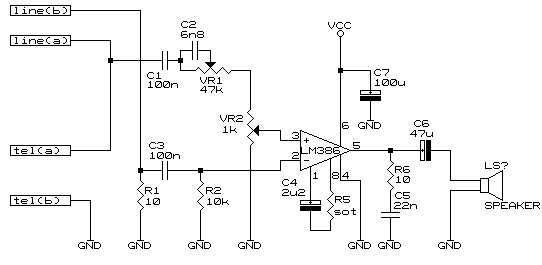|
Overview: The unit described allows for the monitoring of a telephone or modem connected to a telephone line but with one advantage over the conventional 'tap across the line' method. This unit enhances the incoming audio and cancels out the outgoing audio so as to allow equal levels of audio for both incoming and outgoing signals. With careful adjusting the unit can even have enhanced incoming and low outgoing (for example listening to a modem connection where the incoming audio is important during fault finding modem problems etc.). Circuit Description. The heart of the circuit is a LM386 audio amp. This device boasts a low quiescent current and also a balanced input. R1 allows for a small portion of the audio to be monitored across the negative input (capacitor C3 blocks any DC generated across R1). The phase, however, of the signal across R1 is negative with respect to the line on incoming audio but positive to the line on outgoing audio. Therefor, if a small amount of signal from the line is fed to the opposing input the result cancels the non-required audio (outgoing) but actually enhances the required audio (incoming) as they add in the amp. The adjustment VR1 with C2 creates a phase adjustment to counteract line capacitance so as to achieve the best possible cancelling. C4 and R5 set the gain of the '386 and may be adjusted at leisure and have no effect on the circuit performance. C5 and R6 are oscillation dampening requirements for the '386. Uses for the circuit. The circuit was primarily designed to monitor the quality of a modem connection during the connected period. It allowed for the modem itself to be set with the speaker off and then the line monitored at any time by turning the unit on. An example of this was during file downloads when the transfer would stop for no apparent reason. The monitor was turned on only to discover the modems trying to re-train themselves during a 'call waiting' signal! Other 'line faults' discovered have been lightning induced noises and bad connections. Related to the above was using this unit to monitor fax transmissions overseas where bad 'negotiation phases' resulted in time spent 'doing nothing' by the fax machines yet costing loads of money and a saving was realised by cancelling the call and retrying manually and not waiting for the fax machine's 60 seconds before it cancelled the call. Another small saving was also realised by having a switch in the telephone line and ensuring that the line was released as soon as the two machines had negotiated the close-down. Some of the more modern machines take about 5 seconds to release the line after the receiving machine has 'put down', this period is charged to you! Further uses include recording telephone conversations where the normal tap across line method results in the outgoing audio being as much as 20dB greater than the incoming. This causes the ALC on cheaper recorders to blot out the first few words of the other party and more expensive recorders (with a recording level) to distort the outgoing audio. The normal method of getting past this problem is to tap across the earpiece of the telephone as this generates an approximately balanced level but requires the telephone instrument to be modified. This circuit alleviates both problems. With a simple lead constructed and plugged into the unit the unit becomes a handy audio signal tracer with no additional parts. If sensitivity is required then VR1 could be shorted momentarily, however, watch out for VR2 (it's only 1k-ohm and could load the device under test!). Using a transformer in the output will allow the unit to be coupled to a device that sits at earth potential (such as the above mentioned audio recorder).
© 14.08.00 |
